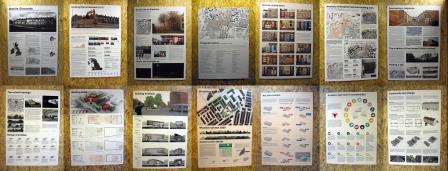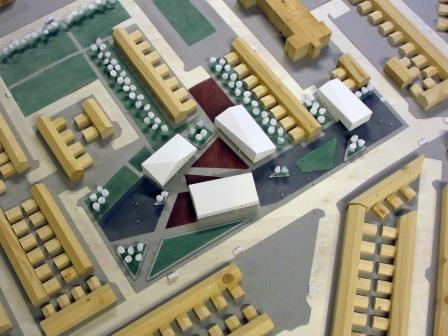Diploma 2014: "Battle Grounds" by Robert Moe
Reclaiming a community from a failed attempt at urban renewal
The £2.2 billion urban regeneration program covering 10 urban areas in the North of England was set up in order to address a growing wealth divide between the North and South of the country. Far from being a success, it's legacy is streets upon streets of empty terrace houses and decimated communities. BattleGrounds is an analysis and response of the situation, specifically focusing on Gresham, a ward of the town of Middlesbrough.
In the late 1990s housing associations in the North of England began voicing concerns abouthouse prices in their regions which were standing still or dropping when compared to housing market in the South of England. This was creating a wealth divide within the country with the South getting richer and the North getting poorer which in turn led to a situation where peoplein the north were unable to afford to move south and people in the south were able to buy“portfolio’s” of cheap houses in the north with the view to profit through renting. One of the knock on effects of “buy-to-rent” was the creation of neighbourhoods of transient rental residentsthat had less attachment to the property or the area that they lived in. This situation creates neighbourhoods where residents live for a finite amount of time, eroding the sense of community within the area and perpetuating the situation.
The Housing Market Renewal (HMR) initiative was a large scale (£2.2 billion) urban redevelopment plan aimed at stabilising the housing market in the North of England based on a report by the Centre for Urban and Regional Studies (CURS) at the University of Birmingham headed by Professor Brendan Nevin. HMR was started in 2002 and aimed, as it’s name clearly states, to renew the market of failing housing areas. This would be achieved through a combination of refurbishment and, more controversially, a program of demolition/new build. In the demolition/new build program,the idea was that the HMR money could be used to pay for the removal of residents and the demolition of the existing housing stock. Then private developers would take control of the area,developing new housing that they would sell. In such a way, the developers would make a profit and the local councils would be able to deal with problem areas.
The HMR initiative was in full flow, with many people already moved from their homes, when the Global Financial Crisis hit. Within a very short space of time the funding dried up and the project was all but abandoned. Local councils were left in a situation where they had cleared rows upon rows of houses of their residents but no longer had the funds to demolish them. The problem was compounded by the fact that the private developers that had signed up to do the development work retracted their interest. For these developers the project was no longer financially viable as the homes that they had planned to build would have been marketed towards people that, underthe economic climate of the time, would struggle to get a mortgage.
This diploma project investigates the impact that HMR has had on a specific community, the ward of Gresham in Middlesbrough, an industrial town located in the North east of England. Findings that were based on research and a three week long study trip to the area acted as a point of departure that informed the architectural response; A School offering entry level qualifications (GNVQ) in construction. The concept being that students enrolled at the school would use the 287 empty houses in Gresham to practice their newly acquired skill sets that they learn at the school with the aim of renovating the buildings and returning them to the social housing market.
Whilst the terraced houses that dominate the built environment within the HMR areas and are viewed as a negative result of a failed urban development program, through the building a
school these houses can become a resource. The school then becomes a motor to not only deal with the housing problem but also begins to address many of the layers of complexity wrapped up in the social problems of the area. In such a way the diploma project has developed a holistic strategy to regenerating an area that was in desperate need for a new approach.
All photos. Robert Moe

Exhibition space built as a 1:1 scale model of a typical Middlesbrough terrace house.

DAV 1:1 project, wallpapering an abandoned house with golden wrapping paper.

Project displayed as a series of 14 posters.

Model of final design project.
